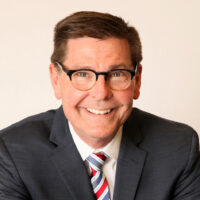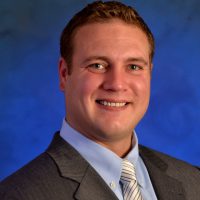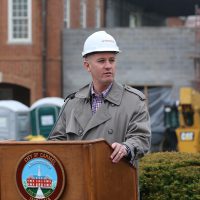Four Republican candidates are running in the May 2 primary election for three at-large positions on the Carmel City Council. The winner will face Democrats Sara Draper and Jake Madore in the Nov. 7 general election.
The candidates are incumbent Jeff Worrell, a strategic consultant for Advantage Medical; Matt Snyder, a Clay Township board member and engineering consultant; Rich Taylor, president of the Carmel Clay Parks & Recreation board who works in construction and consulting; and Jonathan Blake, a regional planning professional. They answered the following questions from Current:




Carmel is often criticized for its debt load. Do you believe Carmel has too much debt?
Worrell: Absolutely not. Carmel has been smart in its use of debt to support infrastructure, and that has helped to continue to build assessed value. This has allowed Carmel to provide world-class services and amenities without having residential taxpayers foot the bill (residential taxpayers only support about 13 percent of Carmel’s total debt). Any conversation that talks about the amount of debt the city has without also talking about revenue is also misleading. Carmel’s debt load is appropriate, and the city is financially strong.
: When looking at the size of Carmel’s debt, you must also look at the revenue of the city. The amount of debt might seem like a lot, but when you compare the overall debt payments to the revenue generated, the total debt number starts to make a lot more sense. Carmel’s debt to income ratio is very good, and the city has a proven ability to pay our bills and offer residents quality amenities and services while keeping taxes low.
Taylor: The conversation about debt in Carmel is a source of a lot of misunderstanding. Many of the conversations don’t include a discussion about the revenue that the city generates or who is responsible for paying back some portions of the debt (as in the case of utility or developer-backed TIF bonds). When looking at the overall financial picture, I feel that Carmel’s amount of debt is appropriate based on its total assessed value and debt service payments as a percentage of annual revenue. I am an advocate that the city develop a capital asset management plan to prepare for the maintenance and replacement needs of city assets in the future.
Blake: While debt is usually raised in a negative light in election cycles, not all debt is created equal. Debt, when managed properly, is a resource that allowed Carmel to attract corporate headquarters, develop a robust parks system, invest in roads and trails, and spur redevelopment of the city’s central core. As a result of this continued reinvestment, Carmel has received countless accolades. The city’s current debt service accounts for approximately 17 percent of its annual budget. However, our city is a crossroads, for the first time in nearly 30 years the residents of Carmel will choose a new mayor and six new council members, resulting in completely new leadership for the city. Looking ahead, we need to ensure that Carmel voters, business owners and residents have a seat at the table, to prioritize city investments, pass balanced budgets and maintain a strong fiscal position.
How should the city balance redevelopment with maintaining the character of surrounding, well-established areas?
Worrell: Different parts of Carmel require different levels of density and walkability. Denser areas are easier to build to be walkable, but it’s important that residents throughout the city have access to whatever services they require without the need to always get into a car. I believe that we have a balanced mix, but what that means is different across the various regions of the city. I support zoning that is focused on mixed-use of available land instead of dividing it into zoning blocks. But what is needed in the central core differs from what the west or east sides are looking for, and it’s important to keep that in focus as we are planning. One size fits all doesn’t work.
Snyder: I think there needs to be a major study about what the needs of Carmel are. The market should dictate what strategies are used to meet the community’s needs, but we can help by providing information about what Carmel’s businesses and homeowners are asking for. We need a strategy that is resident driven that takes into account the needs and desires of the community and plans for those needs for now and in the future.
Taylor: Smart development must promote trails, parks, greenspaces, and quality of life assets that support home values and long-term stability. There are opportunities to create density in the city core, but those opportunities must be focused on where they will have the most positive impact on the community and least negative impact to current residents.
Blake: Redevelopment plays a vital role in the success of our city, and it has provided many of the amenities our residents have come to enjoy, including the Monon Boulevard, Midtown Plaza, the Center for the Performing Arts and countless businesses that now call Carmel home. However, there has been very little opportunity for community engagement with these projects, resulting in increased development pressures on local neighborhoods and leaving many residents feeling unrepresented when these projects are being considered. As a community and regional planning professional, I have firsthand experience in balancing the pressures for redevelopment while preserving the character of local neighborhoods. As a member of the city council, I will work with the council and the mayor to ensure the CRC’s financial records are open and transparent and increase opportunities for the public to be engaged during city planning projects and local land use decisions.
The city has devoted 1 percent of its general fund to supporting local arts. Is this an appropriate amount and funding source? Why or why not?
Worrell: I believe that funding for the arts is an important civic function. There are always multiple ways to approach this, and I feel the 1 percent method has been a good method. The organizations that receive this money are creating content that we need in our performing arts facilities, and I fully support continuing this in the future.
Snyder: I support the city spending 1 percent of its general fund supporting the arts, because I feel that it goes a long way to enriching the culture of the community. The city council should have close oversight on how that money is distributed, and the money spent should always focus on promoting the arts inside Carmel.
Taylor: Arts, like parks, trails and other amenities, promotes quality of life in Carmel while helping bring jobs and private investment to the community. I support utilizing a small portion of the city’s budget to help fund local arts organizations. In addition, our community has made a significant investment in the Center for the Performing Arts campus, and it’s important to ensure these organizations are successful to protect the city’s investment.
Blake: Public art builds community, engages residents and spurs conversations; and I will fully support committing 1 percent of the general fund budget to supporting local arts. However, I will also work with the city council and the mayor to establish a public arts commission, appointed by and reporting to the city council, to review and recommend future public art projects, and oversee the arts budget.
The city has had a couple of failed starts in implementing diversity training and initiatives. How do you think the city should handle diversity training?
Worrell: I have attended workshops as a member of the city council, and I fully support bringing awareness and education to all employees about diversity issues in the community. I feel that this is a topic that can be difficult, but it is important. Just because we have hit some bumps in the past doesn’t mean that we should not keep trying to improve — we must continue exploring all avenues to ensure Carmel has a good workplace environment.
Snyder: It’s important to ensure that our city personnel have the proper training for any situation they might be placed in. I support having a strategy that includes training on diversity issues as a part of the ongoing training they receive as a part of their jobs.
Taylor: I believe it is important and valuable to make sure that every employee and citizen feels welcome in Carmel. When talking about diversity training for employees, I feel that the city should bring in outside experts who can ensure that this training is handled like it is in the corporate world as an ongoing part of employee training.
Blake: The diversity of Carmel’s population is growing each year; and we need to ensure that our community is open and inclusive to everyone, regardless of religious beliefs, gender, race, ethnicity, social class, physical ability or sexual orientation. Moving forward I would like to see the city make stronger investments to attract a workforce as diverse as our community.
What should be the city’s role in supporting its senior citizen residents and their needs?
Worrell: I believe that we must have an open dialogue with the city’s senior residents and make sure that we are providing the services they need. This includes continuing to provide entertainment and programs that are designed for seniors. We also must support having a variety of housing options so that seniors have the ability to downsize and stay in the community as their housing needs change.
Snyder: Identifying the needs of one of Carmel’s largest demographics should be a priority of the city and its departments. We need to provide needed services, increase the mobility for seniors throughout the city, and get the word out about programs that already exist and new programs that are implemented. The city should partner with all the organizations, including hospitals, to make sure that there is a strategic plan in place as more residents reach retirement age and beyond.
Taylor: First and foremost, Carmel must find a way to provide more diverse housing that ensures seniors have affordable options as their needs change later in life. We must partner with local organizations to provide services to seniors, and we must maintain low property taxes to allow those who are on fixed incomes to plan for the costs associated with living in the community.
Blake: Based on the 2020 Census, approximately 14.1 percent of Carmel’s residents are 65 years or older. One of the biggest concerns I’ve heard from these constituents, particularly in downtown Carmel, is the fear that they will be “pushed” out of their homes due to gentrification and redevelopment of their neighborhoods. As a city, we need to promote diverse housing options, ensuring that residents are able to age-in-place; replace deteriorating sidewalks to increase mobility; and conduct town hall-style meetings to encourage interaction with elected and appointed officials.
What is Carmel doing well? What is its area in need of most improvement?
Worrell: Carmel has a proven record for bringing in companies who want to bring their jobs to the city as well as providing opportunities for residents and their variety of needs and wants. Carmel has plenty of room to improve in many areas, but I feel the most pressing is being better about including every resident in the process of government as well as continuously improving our communication about what is being done and why.
Snyder: Carmel’s parks, roads, trails, and other amenities are all world class. As a city we can never be done, and have to continue to push forward to be cutting edge in everything we do.
Taylor: Carmel excels at providing recreation, entertainment and services that improve the quality of life for all residents. We need to ensure that the financial models that have been used to build Carmel’s assets are sustainable in the future. Carmel needs to develop a comprehensive asset management plan to budget and forecast for future needs. We have had a lot of development that was built at the same time, and we need to make sure that we are able to maintain it.
Blake: Civic engagement is critical to the success of any community; to ensure accountability and transparency, address neighborhood issues, build community consensus, and promote better planning. I am committed to improving public engagement through town hall meetings, attending neighborhood gatherings and open lines of communication with Carmel residents. Over the past 27 years Carmel has been led by the vision of Mayor Jim Brainard, and we are fortunate for his leadership. However, the residents of Carmel should have a seat at the table, fostering a vision for the future of our city.




